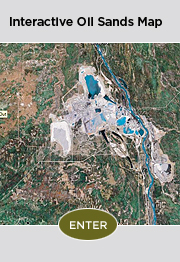Toe-to-Heel Air Injection (THAI)
Like CSS and SAGD, THAI® technology also uses heat to reduce
the viscosity of the bitumen; however, the heat is generated underground by the
combustion of a small portion of the bitumen in the reservoir. Employed
exclusively by Petrobank Energy and Resources Ltd., THAI® technology uses two
wells; a vertical air injection well with a horizontal production well. Rather
than steam, THAI® technology injects air and then relies on underground
combustion of a portion of the oil in the ground to generate the heat required
to “melt” the remainder of the bitumen and allow it to drain down in to the
production well.
Air is forced into the upper portion of the reservoir from
an injection well. The oxygen contained in the air combines with the heavier
fractions of the oil and causes combustion in the reservoir. The combustion reaction then smolders like the embers of a campfire and creates a vertical wall of hot gases. This
firewall moves from the injection well (the toe) to the production well (the
heel), pushed forward by the pressure of the injected air, causing the heavier
oil components to burn and softening the lighter components permitting them to
flow ahead of the combustion front and into the production well where they can
be pumped to the surface.
THAI® technology has the potential to be much less energy
intensive than other in-situ technologies because the bitumen “cokes,” meaning
it sheds heavy carbon molecules as it moves through the ground towards the
production well. This results in a lighter, partially upgraded oil product
being brought to the surface, meaning less life-cycle GHG emissions overall as
it also reduces the amount of energy-intensive surface upgrading that the
produced oil has to undergo. As well, minimal natural gas is used in the
process and, as there is little steam required, very little water is used and
reservoir water is actually produced and has the potential to be used for
industrial applications.
Overall, THAI® technology produces 50% fewer GHGs than other
oil sands production methods, requires very low water use and, like other
in-situ projects, has a minimal surface footprint.




















